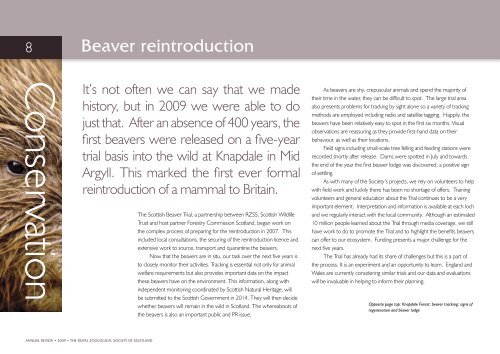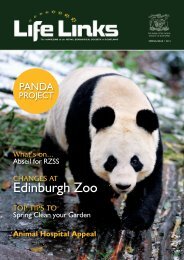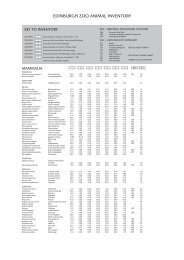THE ROYAL ZOOLOGICAL SOCIETY OF SCOTLAND - Edinburgh Zoo
THE ROYAL ZOOLOGICAL SOCIETY OF SCOTLAND - Edinburgh Zoo
THE ROYAL ZOOLOGICAL SOCIETY OF SCOTLAND - Edinburgh Zoo
Create successful ePaper yourself
Turn your PDF publications into a flip-book with our unique Google optimized e-Paper software.
8<br />
Conservation<br />
Beaver reintroduction<br />
It’s not often we can say that we made<br />
history, but in 2009 we were able to do<br />
just that. After an absence of 400 years, the<br />
first beavers were released on a five-year<br />
trial basis into the wild at Knapdale in Mid<br />
Argyll. This marked the first ever formal<br />
reintroduction of a mammal to Britain.<br />
ANNUAL REVIEW • 2009 • <strong>THE</strong> <strong>ROYAL</strong> <strong>ZOOLOGICAL</strong> <strong>SOCIETY</strong> <strong>OF</strong> <strong>SCOTLAND</strong><br />
The Scottish Beaver Trial, a partnership between RZSS, Scottish Wildlife<br />
Trust and host partner Forestry Commission Scotland, began work on<br />
the complex process of preparing for the reintroduction in 2007. This<br />
included local consultations, the securing of the reintroduction licence and<br />
extensive work to source, transport and quarantine the beavers.<br />
Now that the beavers are in situ, our task over the next five years is<br />
to closely monitor their activities. Tracking is essential not only for animal<br />
welfare requirements but also provides important data on the impact<br />
these beavers have on the environment. This information, along with<br />
independent monitoring coordinated by Scottish Natural Heritage, will<br />
be submitted to the Scottish Government in 2014. They will then decide<br />
whether beavers will remain in the wild in Scotland. The whereabouts of<br />
the beavers is also an important public and PR issue.<br />
As beavers are shy, crepuscular animals and spend the majority of<br />
their time in the water, they can be difficult to spot. The large trial area<br />
also presents problems for tracking by sight alone so a variety of tracking<br />
methods are employed including radio and satellite tagging. Happily, the<br />
beavers have been relatively easy to spot in the first six months. Visual<br />
observations are reassuring as they provide first-hand data on their<br />
behaviour, as well as their locations.<br />
Field signs including small-scale tree felling and feeding stations were<br />
recorded shortly after release. Dams were spotted in July and towards<br />
the end of the year the first beaver lodge was discovered, a positive sign<br />
of settling.<br />
As with many of the Society’s projects, we rely on volunteers to help<br />
with field work and luckily there has been no shortage of offers. Training<br />
volunteers and general education about the Trial continues to be a very<br />
important element. Interpretation and information is available at each loch<br />
and we regularly interact with the local community. Although an estimated<br />
10 million people learned about the Trial through media coverage, we still<br />
have work to do to promote the Trial and to highlight the benefits beavers<br />
can offer to our ecosystem. Funding presents a major challenge for the<br />
next five years.<br />
The Trial has already had its share of challenges but this is a part of<br />
the process. It is an experiment and an opportunity to learn. England and<br />
Wales are currently considering similar trials and our data and evaluations<br />
will be invaluable in helping to inform their planning.<br />
Opposite page top: Knapdale Forest; beaver tracking; signs of<br />
regeneration and beaver lodge





